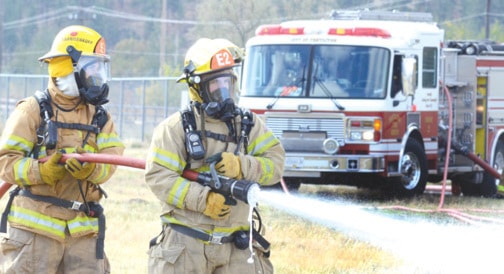The walking wounded were the first to be pulled from the damaged fuselage of the Dash 8 commuter aircraft that crashed after skidding off the runway at Penticton Regional Airport Saturday.
Fortunately the “accident” involving a plane similar to ones used on scheduled Air Canada Jazz flights in an out of Penticton was just a scenario.
While the Transport Canada supervised exercise was not real, it was treated that way by the many participants, ranging from emergency responders including police, fire and ambulance to a large number of civilian agencies.
“You have to approach it as if it is a genuine situation because then you get the most benefit from it,” said Naramata’s Bob Atkinson, BC Ambulance unit chief of 341 station in Kelowna, who was on the frontline dealing with the more than a dozen injured passengers. “It was good out there, I mean it’s always a learning exercise and these are the times to make the mistakes and learn from them.”
Two school buses parked at the northwest end of the airport were used to represent the aircraft and the victims were volunteers.
Overall airport manager Dave Allen noted the mock accident was valuable to all parties involved and participants were committed to doing their best.
“That’s because it is very important to treat it as the real thing because they (responders) don’t often get a chance to practise that together,” he said afterwards. “It’s important they understand each other’s roles and responsibilities and to work together as a unit.
“Success in this case is not how well you did the job, it’s what comes out of it that you feel was lacking to find out where your weak spots are and what you can improve on.”
One area the manager would like to see is better communication between the different response teams, most of which use individual radio frequencies and don’t always connect with each other.
Allen indicated it is a provincewide matter and there has been some indication changes are coming in that regards which would make efforts more cohesive.
Like most smaller airports, Penticton does not have any emergency equipment such as fire trucks on location any more.
Deputy chief Dave Spalding of Penticton Fire Rescue also believes in the need for such exercises.
“It isn’t the real thing and that’s just it, it’s important that we get the training,” he said at the on-site accident headquarters.
“Our role today in the exercise is to give them a hand from the fire perspective. In a real event we would respond to the air crash to help with the patients, we help with the fire we take control of the command post and build the structure from the ground up, from the operations of the first fire truck in to ambulance being involved, RCMP, search and rescue, Interior Health — wherever it needs to go and beyond.”
According to Commissionaire David Kerr, supervisor of security services at the airport, the facility does have an elaborate emergency plan in place which has been distributed to the appropriate agencies.
“This is a good process and hopefully we’ll never need to use it, but it’s great to have it in place just in case,” he said.
